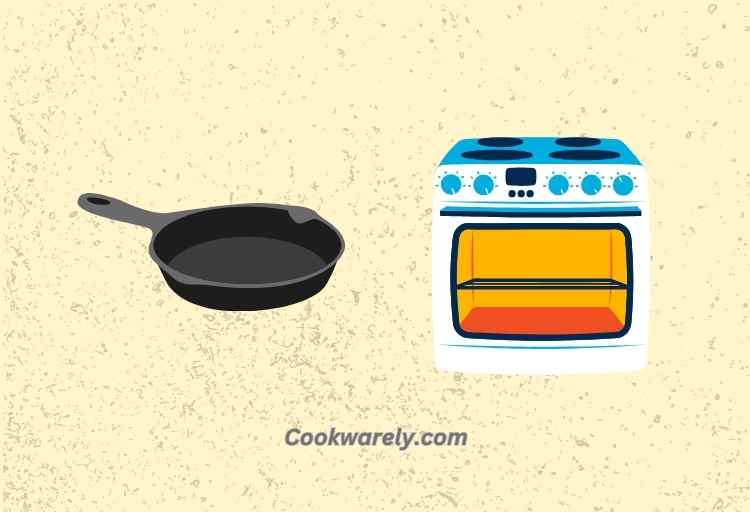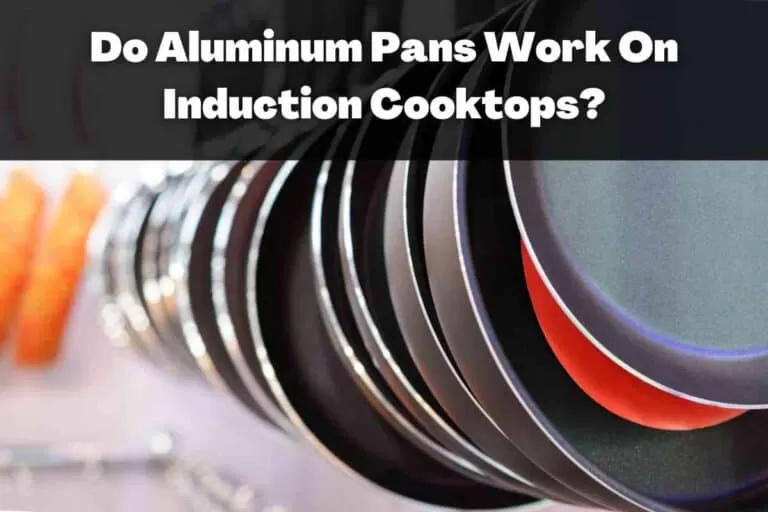Will Cast Iron Scratch An Induction Cooktop? Explained!
Cast iron cookware is versatile and suitable for various cooking methods, from stovetop to oven. Induction cooktops enhance this versatility by providing a reliable and controlled heat source.
Yes, cast iron cookware can potentially scratch the glass surface of an induction cooktop due to its rough bottom surface. To prevent scratches, avoid sliding the cookware, use protective barriers like paper towels, and consider enameled cast iron as a smoother alternative.
Cast iron is magnetic and therefore compatible with induction cooktops, which rely on magnetic fields to heat the cookware. This compatibility ensures efficient energy transfer.
Also, cast iron is an excellent conductor of heat, and when placed on an induction cooktop, it quickly and evenly distributes heat throughout the cookware. This results in precise and efficient cooking.
Additionally, cast iron’s ability to retain heat makes it ideal for dishes that require consistent temperature control, such as searing, frying, and slow simmering. Induction cooktops allow users to adjust temperatures with precision.
5 Tips To Use Cast Iron on Induction Cooktop
| Tips | Description |
|---|---|
| Avoid Sliding | Lift cast iron cookware instead of sliding it across the cooktop to reduce friction. |
| Use Protective Barriers | Place paper towels or kitchen towels between the cookware and cooktop to act as a protective barrier. |
| Consider Smoothing | Smooth the rough bottom of cast iron cookware through sanding or grinding to make it more induction-friendly. |
| Explore Enameled Cast Iron | Enameled cast iron is a smoother alternative to traditional cast iron and is less likely to scratch the cooktop. |
| Regular Cleaning | Maintain the cleanliness of both cookware and the induction cooktop to prevent small debris from causing scratches. |
Key Takeaways
- Surface Smoothness: Pay attention to the bottom surface of your cast iron cookware. A smooth surface reduces the risk of scratching the induction cooktop. Consider smoothing rough spots if necessary.
- Protective Measures: To prevent scratches on the glass surface, avoid sliding cast iron pans and use protective barriers like paper towels or kitchen towels between the cookware and cooktop.
- Cleaning and Maintenance: Properly clean and maintain your cast iron cookware to ensure its longevity and effectiveness. Avoid soap, use a scraper when needed, and periodically re-season the cookware to maintain its non-stick properties.

How Do Induction Cooktops Work?
Before we dive into the cast iron conundrum, let’s understand how induction cooktops operate.
Unlike gas or electric stoves, induction cooktops use electromagnetic technology to heat your cookware directly.
When you place a compatible pot or pan on the surface, the magnetic field induces electrical currents in the cookware, generating heat.
This method is not only highly efficient but also incredibly fast, allowing you to cook your meals swiftly.
Will Cast Iron Scratch an Induction Cooktop?
Yes, there is a potential risk of cast iron cookware scratching an induction cooktop. Induction cooktops rely on magnetic fields to heat compatible cookware, and cast iron is one such material that works well with them due to its magnetic properties and excellent heat conductivity.
However, the issue arises from the often rough or uneven bottoms of cast iron cookware. When moved or slid across the glass surface of an induction cooktop, these rough surfaces can create friction and potentially lead to scratches.
While these scratches are typically cosmetic and don’t affect the cooktop’s functionality, they can diminish its appearance over time.
To prevent scratching, it’s essential to handle cast iron cookware with care when using it on an induction cooktop.
Avoid sliding the cookware and instead lift it to reduce friction. Additionally, placing a protective barrier like paper towels or kitchen towels between the cookware and the cooktop can help prevent scratches.
Some cooks also opt for smoothing the bottom of their cast iron cookware or choose enameled cast iron, which has a smoother surface and is less likely to scratch the cooktop.
Regular cleaning of both the cookware and the cooktop is essential to prevent small debris from causing scratches during cooking.
Benefits of Using Cast Iron Cookware with Induction
Now, let’s talk about the benefits of using cast iron cookware on your induction cooktop. Cast iron is an excellent conductor of heat, and this is precisely what makes it a great match for induction cooking.
The iron composition of cast iron cookware allows it to respond quickly to changes in temperature, providing precise control over your cooking.
Additionally, cast iron retains heat exceptionally well, which is perfect for dishes that require even and prolonged cooking, such as braises and stews. The result is a more efficient and versatile cooking experience.
The Risk of Scratching
However, it’s not all sunshine and rainbows when it comes to using cast iron on induction cooktops.
There is indeed a risk of scratching the glass surface of your cooktop, and here’s why: Cast iron cookware tends to have rough bottoms, and when moved or slid across the cooktop, these rough surfaces can leave scratches behind.
These scratches, while generally cosmetic, can detract from the appearance of your cooktop and potentially affect its resale value. Therefore, it’s essential to take precautions to prevent such damage.
How To Prevent Scratches?
To keep your induction cooktop in tip-top shape, follow these practical tips to prevent scratches:
- Avoid Sliding Cast Iron Pans: When placing or moving cast iron cookware on the cooktop, never slide it. Lift the cookware instead to minimize friction with the glass surface.
- Use Paper Towels as a Barrier: Placing a few layers of paper towels or a kitchen towel between the cast iron and the cooktop can act as a protective barrier and reduce the risk of scratches.
- Consider Smoothing the Bottom: Some cast iron enthusiasts choose to smooth the bottom of their cookware to make it more induction-friendly. This involves sanding or grinding down any rough spots on the cookware’s surface.
- Explore Enameled Cast Iron: Enameled cast iron is a smoother alternative to traditional cast iron. While it may not achieve the same high temperatures, it’s less likely to scratch your induction cooktop.
- Regular Cleaning: Proper maintenance, including regular cleaning of both your cookware and the induction cooktop, is essential. Keeping the cooktop clean can help prevent small debris from causing scratches during cooking.
How to Determine Cookware Compatibility for Induction Cooktops?
Induction cooktops are known for their efficiency and precision in cooking, but they require specific types of cookware that are compatible with their magnetic technology.
If you’re wondering how to know if your cookware is suitable for an induction cooktop, here’s a comprehensive guide to help you determine cookware compatibility.
1. Look for the Induction-Ready Symbol
Many manufacturers now label their cookware with an “induction-ready” symbol or mention its compatibility with induction cooktops in the product description. This is the easiest way to identify cookware that will work seamlessly with your induction stove.
2. Check the Material
Induction cooktops work by creating a magnetic field that heats up compatible cookware. To determine compatibility, check if your cookware is made of magnetic materials. Here are some materials that are compatible with induction cooktops:
- Stainless Steel: Most stainless steel cookware is induction-compatible. However, ensure it has a magnetic bottom, as some types of stainless steel are non-magnetic.
- Cast Iron: Cast iron cookware, like skillets and Dutch ovens, is highly compatible with induction cooktops. It’s naturally magnetic and conducts heat efficiently.
- Enameled Cast Iron: Enameled cast iron cookware also works well with induction cooktops. The enamel layer adds a smooth surface while retaining the magnetic properties of the cast iron.
- Carbon Steel: Similar to cast iron, carbon steel cookware is magnetic and works wonderfully with induction stoves.
3. Perform the Magnet Test
If you’re unsure about your cookware’s compatibility, you can perform a simple magnet test. Here’s how:
- Grab a refrigerator magnet or any strong, flat magnet.
- Turn on your induction cooktop and set it to a low heat setting.
- Place the magnet on the bottom of your cookware.
- If the magnet sticks firmly to the bottom of the cookware, it’s induction-compatible. If it doesn’t stick or only sticks weakly, it’s not suitable for induction cooking.
4. Check the Bottom Surface
Inspect the bottom of your cookware. Induction-compatible cookware typically has a flat and smooth magnetic bottom. The surface should be even without any ridges or patterns that could disrupt the contact between the cookware and the induction cooktop.
5. Read the Manufacturer’s Instructions
Always refer to the manufacturer’s instructions that come with your induction cooktop. They often provide specific recommendations on the types of cookware that are best suited for your particular model.
6. Ask the Retailer or Manufacturer
If you’re still unsure about compatibility, reach out to the retailer or the cookware manufacturer. They can provide guidance and information about whether your specific cookware is suitable for use with induction cooktops.
Caring for Cast Iron Cookware
While we’re discussing cast iron, let’s touch on how to care for your cast iron cookware, which can be effectively used on induction stoves without scratching with proper care:
- Avoid Soap: Don’t use soap to clean cast iron as it can strip away the seasoning. Instead, rinse with hot water and scrub gently.
- Use a Scraper: Stubborn food residue can be removed with a scraper designed for cast iron. Be gentle to avoid damaging the cookware’s surface.
- Maintain Seasoning: To keep your cast iron in top condition, lightly swab it with oil and bake it periodically. This process maintains the seasoning, which enhances the cookware’s non-stick properties.
Additional Tips for Cooktop Protection
To further safeguard your induction cooktop, consider these tips:
- Specialized Cleaning Products: Invest in specialized cooktop cleaning products that offer protection against scratches and maintain the glass surface’s shine.
- Mindful Cookware Movement: Be mindful when moving cookware on the cooktop. Avoid sudden, heavy placements that could cause scratches.
- Avoid Dropping Pots and Pans: Never drop heavy pots or pans onto the cooktop, as this can lead to cracks or damage to the glass surface.
- Use Silicone Baking Mats or Parchment Paper: Placing silicone baking mats or parchment paper between your cookware and the cooktop can provide an extra layer of protection.
- No Hot Lids on Glass: Avoid placing a hot lid directly on the glass surface to prevent heat-related damage.
- Addressing Small Scratches: Small scratches can often be remedied by creating a paste with baking soda and water or using white vinegar. Apply this mixture gently with a soft sponge and pat the area dry with a cloth.
Conclusion
Using cast iron cookware on an induction cooktop is entirely feasible and offers numerous benefits in terms of cooking performance.
However, it’s crucial to take precautions to prevent scratches on the glass surface. By following these guidelines, you can enjoy the efficiency of induction cooking while keeping your cooktop in pristine condition.






